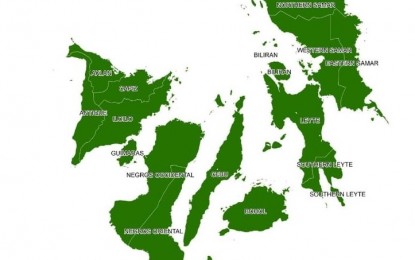
ASF-FREE VISAYAS. The map of Visayas categorized as a green zone, which means these provinces are free from African swine fever (ASF). With Eastern Visayas still ASF-free and also the total ban of pork products from affected areas, neighboring provinces do not have to impose strict quarantine measures of meat products from Leyte and Samar, Department of Agriculture Eastern Visayas regional regulatory division chief Brenda Pepito said on Thursday (Feb. 27, 2020). (Photo courtesy of Department of Agriculture)
TACLOBAN CITY – Neighboring provinces do not have to impose strict quarantine measures on meat products from Leyte and Samar, as Eastern Visayas is still free of African swine fever (ASF) and with the imposition of a total ban of pork products from affected areas.
Brenda Pepito, Department of Agriculture-Eastern Visayas regulatory division chief, said there has been a total lockdown of live pigs and pork products from Mindanao and Luzon as imposed by three provincial governments in ports of entry and exit points.
“Our central office has classified the region as a dark green zone, which means we are free from the ASF virus,” Pepito told the Philippine News Agency on Thursday.
The official issued the statement after the Bohol provincial veterinary office has raised concern over a possible shipment of banned and undocumented livestock from Bato, Leyte, a port town that has a direct roll-on roll-off (Ro-Ro) ferry route to Ubay, Bohol.
“It is very unfair since we are ASF-free and there has been lockdown in five provinces. It is also very impractical for our local hog raisers to bring pork products to Bohol since we have our slaughterhouses here and the local demand is high. No one will ship meat products to Bohol without documentary requirements,” Pepito said.
Quarantine officers have been deployed in seaports of San Ricardo and Liloan ports in Southern Leyte; Balwharteco, Dapdap, and Santa Clara ports in Allen, Northern Samar; and San Isidro port, also in Northern Samar.
The ports in Southern Leyte are the entry points from Mindanao while wharves in Northern Samar are the region’s gateway from Luzon.
Some areas of Luzon and Mindanao have confirmed ASF cases.
Authorities also set up checkpoints in Allen and San Isidro in Northern Samar; Calbayog City in Samar; San Juanico Bridge both in Leyte and Samar side; Liloan, Sogod, and Maasin City in Southern Leyte; Baybay City in Leyte; Biliran in Biliran; Lawaan and Taft in Eastern Samar.
“Before a live hog and a meat product enter Leyte provinces, it has to go through several checkpoints,” Pepito added.
Early this month, the provincial governments of Southern Leyte, Northern Samar, and Samar have issued executive orders temporarily banning the entry of pork and pork-related products in their respective areas to prevent the spread of ASF.
During the meeting of the inter-agency ASF task force, the group came up with two recommendations as possible mitigation against ASF.
The first recommendation is for partner local governments to impose either a temporary total ban for a period of at least three months or a selective ban only.
Second is revisiting the ASF regional action plan by identifying or suggesting specific actions to prevent, manage and control the possible entry of ASF-infected live meat or pork and processed products.
As per available data from the Philippine Statistics Authority, 70 to 80 percent of the region's hog supply comes from Mindanao. Only 20 to 30 percent are locally-produced. (PNA)
